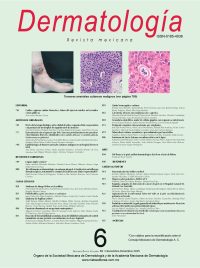Diagnosis of tinea pedis and tinea unguium in the metropolitan area of Monterrey, Nuevo León, Mexico.
Dermatol Rev Mex. 2021; 65 (6): 839-849. https://doi.org/10.24245/dermatolrevmex.v65i6.7146
Michel Stéphane Heya,1 María Julia Verde-Star,2 Sergio Arturo Galindo-Rodríguez,2 David Gilberto García-Hernández,2 Catalina Rivas-Morales,2 Efrén Robledo-Leal3
1 Instituto de Biotecnología.
2 Departamento de Química de Productos Naturales, Laboratorio de Fitoquímica.
3 Departamento de Microbiología e Inmunología, Laboratorio de Micología y Fitopatología.
Universidad Autónoma de Nuevo León, Facultad de Ciencias Biológicas, San Nicolás de los Garza, Nuevo León, México.
Resumen
ANTECEDENTES: La tiña es una de las micosis superficiales más frecuentes, representa del 5 al 10% de éstas.
OBJETIVOS: Evaluar la prevalencia de la infección por dermatofitos y establecer la epidemiología en la zona metropolitana de Monterrey, Nuevo León, México, correlacionando esta infección con factores de riesgo, como edad, sexo, diabetes, SIDA, hiper e hipotensión.
MATERIALES Y MÉTODOS: Estudio epidemiológico analítico y transversal, efectuado de noviembre de 2017 a julio de 2018, que incluyó a pacientes que tenían signos y síntomas compatibles con infección por dermatofitos en las uñas y los pies. Los pacientes se sometieron a una evaluación clínica en un formato estándar que incluyó una combinación de variables epidemiológicas.
RESULTADOS: Se incluyeron 168 pacientes de los que el 83.3% tuvo un examen microscópico directo positivo a prueba de infección, mientras que la prevalencia de dermatofitosis (cultivo positivo) fue del 22%. T. rubrum (45%) fue la especie más frecuente, seguida de T. mentagrophytes sensu lato (23%), Epidermophyton floccosum (9%), T. tonsurans (7%) y Trichophyton spp (17%).
CONCLUSIONES: T. rubrum y T. mentagrophytes sensu lato (23%) fueron los agentes etiológicos más frecuentes y su diagnóstico certero constituye una de las principales herramientas para un tratamiento adecuado y eficaz, evitando así fracasos terapéuticos y el desarrollo de cepas fúngicas resistentes.
PALABRAS CLAVE: Tiña; micosis; dermatofitosis.
Abstract
BACKGROUND: Ringworm is one of the most frequent superficial mycosis, representing 5 to 10% of these.
OBJECTIVES: To evaluate the prevalence level of dermatophyte infection and to establish the epidemiology in the metropolitan area of Monterrey, Nuevo Leon, Mexico, correlating this infection with risk factors such as age, gender, diabetes, AIDS, hyper and hypotension.
MATERIALS AND METHODS: An analytical and transversal epidemiological study carried out from November 2017 to July 2018, including patients with signs and symptoms compatible with infection due to dermatophytes in nails and feet. Patients were submitted to a clinical evaluation in a standard format including a combination of epidemiological variables.
RESULTS: There were included 168 patients, from which 83.3% had a positive direct microscopic examination proofing infection, while the prevalence of dermatophytosis (positive culture) was of 22%. T. rubrum (45%) was one of the most frequent species, followed by T. mentagrophytes sensu lato (23%), Epidermophyton floccosum (9%), T. tonsurans (7%) and Trichophyton spp (17%).
CONCLUSIONS: T. rubrum and T. mentagrophytes sensu lato (23%) were the most frequent etiological agents and its certain diagnosis is one of the main tools for the proper and efficient treatment, so avoiding therapeutical failures and the development of resistant fungal strains.
KEYWORDS: Ringworm; Mycosis; Tinea; Dermatophytes.
Recibido: febrero 2021
Aceptado: marzo 2021
Este artículo debe citarse como: Heya MS, Verde-Star MJ, Galindo-Rodríguez SA, García-Hernández DG, Rivas-Morales C, Robledo-Leal E. Diagnóstico de la tinea pedis y tinea unguium en la zona metropolitana de Monterrey, Nuevo León, México. Dermatol Rev Mex 2021; 65 (6): 839-849.

